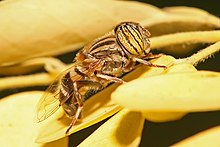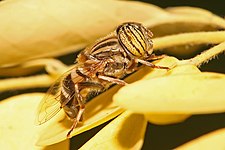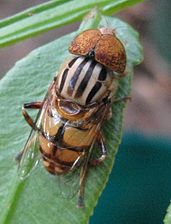Eristalinus
| Eristalinus | |
|---|---|

| |
| Eristalinus fuscicornis | |
| Scientific classification | |
| Domain: | Eukaryota |
| Kingdom: | Animalia |
| Phylum: | Arthropoda |
| Class: | Insecta |
| Order: | Diptera |
| Family: | Syrphidae |
| Tribe: | Eristalini |
| Genus: | Eristalinus Rondani, 1845[1] |
| Type species | |
| Musca sepulchralis | |
| Subgenus | |
| |
Eristalinus is a genus of hoverfly. Most species have very distinctive eye marking in the form of spots or banding, though these features may fade on some preserved specimens. Most are stout flies, and are nimble flyers, even compared to other hoverfly species.
Systematics[edit]
At one time the members of this genus were divided into three clades (Eristalinus, Eristalodes and Lathyrophthalmus) based on morphological characters such as whether the eyes were spotted or striped. Recently Pérez-Bañon et al. studying the European species of Eristalinus using a combination of molecular data and male genitalia characters have determined that the genus in Europe at least, divides neatly into two clades - Eristalinus (+ Lathyrophthalmus) & Eristalodes. It was also discovered that the eye patterning was not taxonomically important as Eristalodes contained members with eyes either spotted or striped.[4][5][6]
The following list is an attempt to organise some of the species under subgeneric headings:
List of species by subgenus[edit]
Gallery[edit]
References[edit]
- ^ a b Rondani, C. (1845). "Ordinamento sistematico dei generi italiani degli insetti ditteri [part]". Nuovi Ann. Sci. Nat. Bologna 1844. 2 (2): 443–459.
- ^ a b Mik, J. (1897). "Einige Bemerkungen zur Dipteren-Familie der Syrphiden [part]". Wiener Entomologische Zeitung. 16: 61–66. doi:10.5962/bhl.part.12834. Retrieved 6 July 2021.
- ^ a b Curran, C.H. (1931). "Records and descriptions of Syrphidae from North Borneo including Mt. Kinabalu". Journal of the Federated Malay States Museums. 16: 333–376.
- ^ Brigitte Howarth (2006). "Diptera of the UAE - collated records from the literature with additions of new records, accompanied by some notes on Mydidae and Stratiomyidae new to the UAE" (PDF). Tribulus. 16 (2). Abu Dhabi: Emirates Natural History Group: 24–29. Archived from the original (PDF) on 28 July 2011. Retrieved 6 January 2009.
- ^ Hassan Ghahari; Rüstem Hayat; Mehrdad Tabari; Hadi Ostovan (2008). "Hover Flies (Diptera: Syrphidae) From Rice Fields and Around Grasslands of Northern Iran" (PDF). Munis Entomology & Zoology. 3 (1). Ankara, Turkey: Munis Research Group: 275–284. Retrieved 6 January 2009.
- ^ F. Christian Thompson (2003). "Austalis, a new genus of flower flies (Diptera: Syrphidae) with revisionary notes on related genera" (PDF). Zootaxa. 246: 1–19. doi:10.11646/zootaxa.246.1.1. ISSN 1175-5326. Archived from the original (PDF) on 2010-01-23. Retrieved 2010-01-31.
- ^ a b c Barkalov, A.V. "Syrphidae collection of Siberian Zoological Museum". Novosibirsk, Russia: the Institute of Animal Systematics and Ecology, Siberian Branch of the Russian Academy of Sciences. Archived from the original on October 20, 2008. Retrieved 28 July 2009.
- ^ a b c d e Bezzi, Mario (1915). The Syrphidae of the Ethiopian region based on material in the collection of the British Museum (Natural history) : with the descriptions of new genera and specie. London: British Museum (Natural History). Department of Entomology. pp. 1–146. Retrieved 26 December 2018.
- ^ Perez-Banon, C.; Rojo S.; Stahls G.; Marcos-Garcia M. A. (2003). "Taxonomy of European Eristalinus (Diptera: Syrphidae) based on larval morphology and molecular data" (PDF). Eur. J. Entomol. 100 (3): 417–428. doi:10.14411/eje.2003.064. ISSN 1802-8829. Retrieved 31 January 2011.
- ^ Thompson, F. Christian (2019). "A new Afrotropical Eristaline flower fly (Diptera: Syrphidae)". Entomologist's Monthly Magazine. 155 (4). Pemberley Books (Publishing): 258–262. doi:10.31184/M00138908.1554.3968.
- ^ Speiser, P. (1910). 5. Cyclorapha. Pp. 113-198. In Sjostedt, Y. (ed.), Wissenschaftliche Ergebnisse der schwedischen zoologischen Expedition nach dem Kilimandjaro, dem Meru und den umgebenden Massaisteppen, Deutsch-Ostafrikas 1905-1906. Vol. 2. Stockholm: P. Palmquists Aktiebolag. pp. 202 pp., 2 pls.
External links[edit]
 Media related to Eristalinus at Wikimedia Commons
Media related to Eristalinus at Wikimedia Commons- For photos of North American species see BugGuide page: http://bugguide.net/node/view/33249/bgimage?from=0







